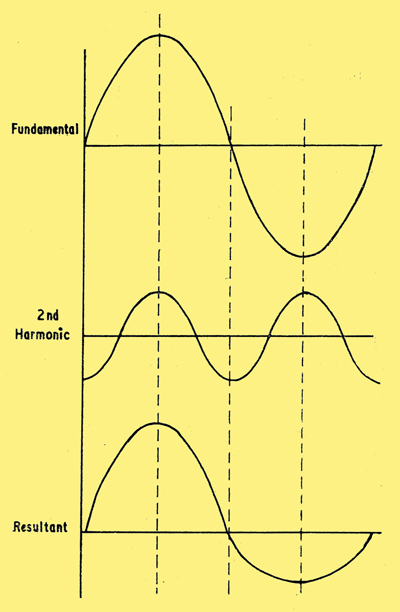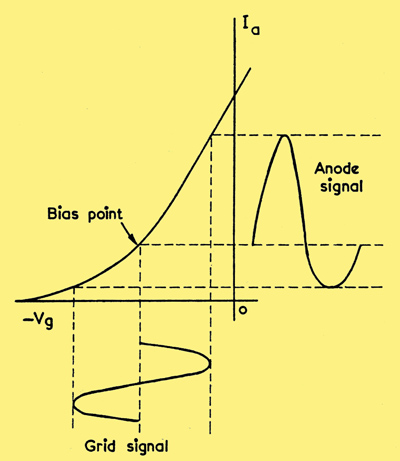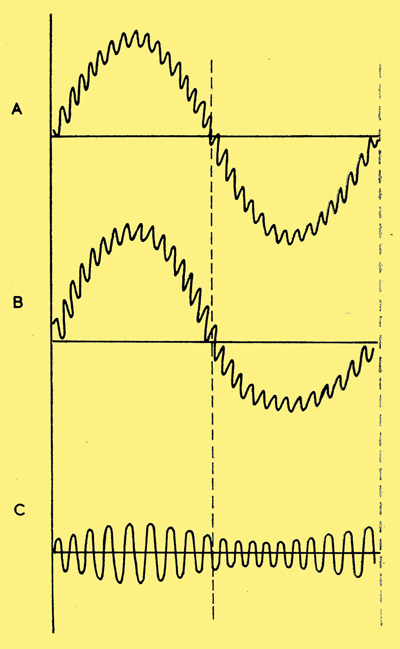|
Audio Distortion
The increasing interest which is being shown by constructors in high fidelity amplifiers has been apparent for some time now. It has frequently been noted that readers have not fully appreciated the differences between the various types of distortion which may be present in his equipment, and as a result he may be over-hauling the amplifier when in fact it is the speaker which requires attention. This article is therefore being allocated to a short survey of the various forms in which distortion can present itself. There is no doubt that the search for realism in audio reproduction is most absorbing, and one which can provide keen satisfaction as each new step is taken towards perfection.
When a good amplifier is compared in performance with an ordinary radio receiver, the latter can be made to sound lifeless and artificial. A piano may assume the sound of a banjo and a cymbal like the scraping of sand on a piece of tin. Such loss of realism is often attributable to a number of different forms of distortion which have to be traced and eliminated individually. The wider the frequency coverage is made the more obvious will the various forms of distortion become.
Frequency Response
Without adequate coverage of the audio spectrum one cannot hope to obtain realistic reproduction. It is, however, important for the response to be balanced at both ends of the spectrum; to have good bass with little top is as bad as having very good treble with attenuated bass. It is not advisable to spend a lot of effort in extending the top response if, for example, the speaker and its associated transformer are incapable of handling frequencies below about 70 Hz.
The range chosen will depend largely upon such limiting features as the pick-up, the speaker and transformer and the speaker enclosure. A coverage of 40 Hz to 15 kHz is sufficient to reproduce the complete range of orchestral music with no loss which is appreciable to the trained ear. Lack of HF response can remove the higher order harmonics from basic tones which may produce a certain un-naturalness in the reproduction accompanied by a lack of brilliance. On the other hand, a very good top which is not supported by a good bass response can produce an annoying 'thinness' which impairs realism. These effects are avoided by observing the correct balance as indicated above.
Harmonic Distortion
Any distortion of the original waveform which is fed into an amplifier will produce harmonics of the fundamental frequency. Unless this type of distortion is severe, it often goes undetected provided it is not accompanied by some other form of distortion. Harmonics are most readily produced as a result of amplitude non-linearity which occurs during each individual cycle. This does not necessarily mean that the amplifier has amplitude distortion (which means that changes in amplitude at the input do not cause corresponding changes in level at the output. This trouble is described later.).

Showing second harmonic distortion.
The diagram above shows how adding a second harmonic to the fundamental produces a distorted wave-shape.

Second harmonic produced by choice of wrong bias point.
The second diagram illustrates the manner in which a similar second harmonic distortion is produced by incorrect biasing in an amplifier valve causing non-linearity; This is but one example of how harmonics are produced, but it serves to illustrate the principle.
Inter-modulation Distortion
This is perhaps the form of distortion which is most apparent and is usually the most difficult to avoid. It results in a certain confusion occurring in the reproduction, which is usually particularly noticeable on loud passages, making it difficult to pick out any individual instrumentalist. Because of this it is possible for an amplifier which has a remarkably good frequency response to still not give the sharp clear-cut reproduction which is so much sought after. To understand the manner in which inter-modulation distortion occurs, assume an amplifier into which two separate sine waves of different frequencies are fed, the lower frequency wave having the greater amplitude. Now if all is well the output waveform would appear as shown in A below, where both halves of the low frequency wave are of equal amplitude. If, however, non-linearity is present in the amplifier it can distort the lower half of the wave as already shown above and this in turn will reduce the amplitude of the higher frequency signal. The result on this signal is shown in C below, from which it is seen to be amplitude modulated in sympathy with the larger signal. The effect caused by inter-modulation between two separate tones has been demonstrated, the effect upon the very complex series of tones which make up the sound of an orchestra can be imagined. Any reader who possesses two separate sine wave sources may be interested in repeating the experiment described and listening to the results. It will be found that at low volume levels, where the non-linearity of the amplifier is negligible, the two separate tones are clear and easily distinguished. As the volume is advanced to the point at which non-linearity occurs, the output degenerates into a harsh combined note. If all is well this should not occur until the normal point of overload is reached.

Inter-modulation distortion.
Inter-modulation distortion is also produced in the speaker, and, to overcome this, quite complicated double cone loading enclosures have been devised, or conversely twin speakers with a suitable cross-over network are employed. Such arrangements are intended to segregate the greater amplitude bass response from the top notes, thus reducing the risk of inter-modulation.
Amplitude Distortion
As has already been stated, a graph of the output of an amplifier plotted against input should be substantially a straight line. It is claimed that a dynamic range of 70 dB is required to give the maximum realism from modern recording if overloading on the peaks is to be avoided. Because of the wide dynamic range of long playing records, contrast expansion is not employed on modern amplifiers.
Resonance
An abrupt peak or hump in the frequency response curve of the amplifier can cause shrillness if it is in the treble region, or boominess if in the bass. The trouble is sometimes traced to a defective negative feed-back arrangement or a poorly designed output transformer. If the amplifier is in order but the trouble is present, it may be due to acoustic feedback between speaker and pickup or a resonance in the speaker enclosure.
Transient Distortion
The equipment must be capable of responding to sudden impulse sounds without any tendency to overshoot. To test for this characteristic a square wave is fed into the amplifier and the output viewed on an oscilloscope. Any tendency for spikes to appear after the vertical sides of the waveform shows that overshoot is present. This can sometimes be corrected by modifications to the feedback circuit to reduce the dynamic output impedance of the amplifier, and thus improve the speaker damping. If the vertical sides of the square wave appear slightly sloping, this indicates a poor transient response - a defect which should also show up as a poor treble response.
Phase Distortion
Due to the use of capacitative and inductive elements in the amplifier, there will be a small but progressive phase shift across the amplifier as the signal frequency is increased. This will have the effect of shifting the phase of harmonics with respect to their fundamental, but extensive listening tests have shown that within the limits normally encountered this shift is not aurially detectable. It is, however, important to keep the phase shift of that part of the amplifier over which negative feedback is employed to a minimum. For this reason the tone control circuit is rarely included within the feedback loop.
Phasing is important when two or more speakers are used simultaneously in close proximity to each other, and care is thus required when connecting up the speakers.
Wow
This trouble is most readily detectable on a constant tone record, when it will show up as a wavering in pitch of the tone, It is usually traceable to minor deviations in turntable speed.
The various types of audio distortion have been described separately, but in many cases they are attributable to the same fundamental cause. Unless test gear is available to definitely prove the presence of distortion, it must not be assumed to be there merely because it is heard on one recording; the record may be a bad one. Careful listening tests on good quality records are usually necessary before it can be definitely decided that some particular form of distortion has to be eliminated.
|